 Do you have small, grub-like insects in your home? Explore the signs of carpenter ant larvae and what this means for your home. These small larvae are signs of a carpenter ant colony, which can be devastating for your home. Find out more about these tiny intruders and discover how you can enjoy premier carpenter ant pest control Niagara by Truly Nolen Canada.
Do you have small, grub-like insects in your home? Explore the signs of carpenter ant larvae and what this means for your home. These small larvae are signs of a carpenter ant colony, which can be devastating for your home. Find out more about these tiny intruders and discover how you can enjoy premier carpenter ant pest control Niagara by Truly Nolen Canada.
 Do you have small, grub-like insects in your home? Explore the signs of carpenter ant larvae and what this means for your home. These small larvae are signs of a carpenter ant colony, which can be devastating for your home. Find out more about these tiny intruders and discover how you can enjoy premier carpenter ant pest control Niagara by Truly Nolen Canada.
Do you have small, grub-like insects in your home? Explore the signs of carpenter ant larvae and what this means for your home. These small larvae are signs of a carpenter ant colony, which can be devastating for your home. Find out more about these tiny intruders and discover how you can enjoy premier carpenter ant pest control Niagara by Truly Nolen Canada.

